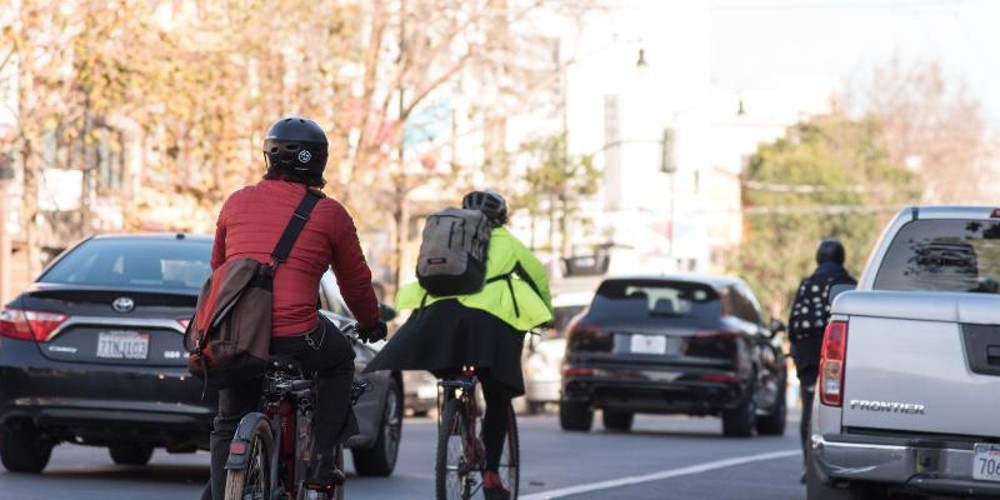Introduction :
San Francisco Municipal Transportation Agency (SFMTA) has been at the forefront of enhancing cyclist safety with the implementation of the Valencia bike lane. However, recent discussions within suggest a potential reevaluation of its design. In this article, we delve into the effectiveness of the current bike lane, explore the reasons behind the proposed reconsideration, and provide expert insights on the matter.The San Francisco Municipal Transportation Agency (SFMTA) has reported that the implementation of the Valencia bike lane has enhanced safety for cyclists. However, there are indications that the agency is considering revising the current design.
Evaluating the Impact: SFMTA’s Perspective
SFMTA reports indicate a significant improvement in safety along Valencia Street since the installation of the dedicated bike lane. According to their data analysis, incidents involving cyclists have notably decreased, showcasing the effectiveness of the current infrastructure in enhancing road safety for cyclists and pedestrians alike.
SFMTA’s Safety Metrics:
utilizes various safety metrics, including accident rates, near-miss incidents, and user feedback surveys, to assess the performance of the Valencia bike lane.Potential revisions to the Valencia bike lane could involve adjustments to its layout, signage, or traffic management strategies. SFMTA may conduct further studies, gather community input, or collaborate with relevant stakeholders to inform any redesign efforts.
Challenges and Considerations :
Despite the apparent success of the Valencia bike lane, SFMTA is contemplating a redesign due to several emerging challenges and considerations.consideration of revising the Valencia bike lane design underscores the dynamic nature of urban planning and transportation infrastructure. It reflects a commitment to adaptability and responsiveness to evolving conditions and community needs.
Increased Congestion:
One of the primary concerns is the observed increase in traffic congestion along Valencia Street, particularly during peak hours. This congestion not only affects vehicular traffic but also impacts the efficiency of public transportation services operating in the area.The ultimate goal remains to create a bike lane that not only enhances safety for cyclists but also integrates well with the surrounding transportation network and meets the needs of all road users. By prioritizing safety and usability, aims to create a more sustainable and accessible urban environment for residents and visitors alike.
Accessibility Concerns:
SFMTA acknowledges feedback from local residents and businesses regarding accessibility issues arising from the bike lane design. Some stakeholders argue that the current layout impedes access to essential amenities and parking spaces, negatively impacting the overall community.
Expert Analysis: Addressing Concerns and Finding Solutions
As experts in urban planning and transportation management weigh in on the matter, various perspectives emerge regarding the potential redesign of the Valencia bike lane.As the city continues to grow and change, willingness to rethink and refine its projects demonstrates a proactive approach to ensuring the long-term effectiveness and safety of its transportation initiatives. By engaging in ongoing evaluation and dialogue, SFMTA strives to create solutions that promote safety, accessibility, and sustainability for all road users in San Francisco.
Balancing Safety and Accessibility:
Experts emphasize the importance of striking a balance between safety improvements for cyclists and maintaining accessibility for all road users. They advocate for innovative design solutions that address the concerns raised by both proponents and critics of the current bike lane configuration.This decision may stem from various factors such as feedback from stakeholders, observed usage patterns, or potential areas for improvement. The willingness to reassess the design demonstrates a commitment to ongoing evaluation and adjustment to ensure the effectiveness and safety of transportation infrastructure in the city.
Integration with Future Projects:
Another aspect under consideration is the alignment of the Valencia bike lane redesign with broader urban development initiatives and future transportation projects. SFMTA aims to ensure that any proposed changes align with long-term sustainability goals and enhance overall urban mobility.
Community Engagement and Feedback
underscores the significance of community engagement in the decision-making process regarding the Valencia bike lane redesign. Through public forums, surveys, and stakeholder meetings, SFMTA seeks to gather diverse perspectives and prioritize community needs in shaping the future of transportation infrastructure in San Francisco.
Evaluating Safety Measures Implemented by SFMTA :
safety measures encompass various aspects, including dedicated bike lanes, improved signage, signal adjustments, and enhanced visibility at intersections. These interventions are purportedly designed to reduce the risk of accidents and enhance overall safety for cyclists traversing Valencia Street.
Understanding Community Feedback
While SFMTA contends that the Valencia bike lane redesign has led to improved safety, community feedback suggests a nuanced perspective. Some cyclists and residents have expressed concerns regarding the effectiveness of the current design in addressing safety issues. Reports of near misses, conflicts between cyclists and motorists, and challenges related to parking and loading zones underscore the complexities associated with urban infrastructure redesign.
Analyzing Potential Design Revisions
Given the divergent viewpoints within the community, SFMTA may consider revisiting the Valencia bike lane design to address existing challenges comprehensively. Potential revisions could involve reassessing lane configurations, implementing additional traffic calming measures, enhancing visibility at critical points, and integrating feedback from stakeholders to optimize safety and usability.
Revisiting Urban Infrastructure Design
In light of evolving transportation needs and safety considerations, urban infrastructure design requires continual assessment and adaptation. approach to redesigning Valencia Street’s bike lane reflects an ongoing commitment to improving mobility and safety for all road users. However, the complex urban environment presents challenges that necessitate flexibility and responsiveness in design and implementation.

Balancing Safety and Accessibility :
Achieving a balance between safety enhancements and maintaining accessibility for cyclists, motorists, and pedestrians is paramount. While dedicated bike lanes offer protection for cyclists, they must integrate seamlessly with existing road networks to ensure efficient traffic flow and minimize disruptions. SFMTA’s challenge lies in optimizing safety without compromising the accessibility and functionality of Valencia Street for all users.
Collaborative Decision-Making
decision-making process regarding bike lane redesigns involves collaboration with various stakeholders, including community members, advocacy groups, transportation experts, and city officials. By fostering open dialogue and soliciting input from diverse perspectives, SFMTA can gain valuable insights into the needs and preferences of Valencia Street’s users, facilitating informed decision-making and consensus-building.
Leveraging Data-Driven Insights
Data analysis serves as a cornerstone of approach to evaluating the effectiveness of bike lane redesigns and informing future planning efforts. By leveraging data-driven insights, SFMTA can identify trends, assess the impact of interventions, and prioritize resources effectively. This evidence-based approach enables to address safety concerns proactively and allocate resources where they are most needed.
Embracing Innovation and Adaptation
As urban landscapes evolve and transportation technologies advance, SFMTA remains committed to embracing innovation and adapting its infrastructure to meet changing needs. From implementing smart traffic management systems to integrating bike-sharing programs and micro-mobility solutions, explores diverse strategies to enhance safety, accessibility, and sustainability in urban transportation.
Future Prospects for Valencia Street
Looking ahead, consideration of potential revisions to the Valencia bike lane design underscores its commitment to continuous improvement and responsiveness to community feedback. By engaging stakeholders, leveraging data insights, and embracing innovative solutions, SFMTA aims to create safer, more resilient, and inclusive urban environments that accommodate diverse modes of transportation and promote active lifestyles.
Leveraging Community Engagement:
SFMTA recognizes the importance of community engagement in shaping transportation policies and infrastructure projects. Through public meetings, workshops, surveys, and online platforms, SFMTA actively solicits feedback from residents, businesses, and advocacy groups to inform decision-making processes. By involving the community in discussions about the Valencia bike lane redesign, demonstrates its commitment to transparency, accountability, and responsiveness to local needs and preferences.
Addressing Concerns and Building Trust
Transparent communication and proactive engagement are essential for addressing concerns and building trust between and the community. By listening attentively to residents’ voices, acknowledging their concerns, and providing timely updates on project developments, SFMTA fosters a sense of ownership and collaboration. This collaborative approach cultivates trust and mutual respect, laying the foundation for successful implementation and acceptance of infrastructure projects.
Promoting Active Transportation and Sustainability
emphasis on enhancing cyclist safety aligns with broader efforts to promote active transportation modes and sustainability in urban mobility. By prioritizing investments in bike infrastructure, SFMTA encourages more residents to embrace cycling as a viable and eco-friendly mode of transportation. Increased cycling not only reduces greenhouse gas emissions and traffic congestion but also promotes public health and well-being by encouraging physical activity and reducing reliance on fossil fuels.
Integrating Multimodal Solutions
approach to urban transportation planning emphasizes the integration of multimodal solutions to accommodate diverse travel preferences and mobility needs. From expanding bike lane networks to improving public transit accessibility and supporting pedestrian-friendly streetscapes, SFMTA strives to create a seamless and interconnected transportation system that offers choice, convenience, and reliability to all residents.
FAQs :
What specific safety improvements have been observed along the Valencia bike lane?
SFMTA’s data indicates a notable decrease in cyclist-involved incidents since the implementation of the Valencia bike lane, showcasing its effectiveness in enhancing road safety.
Why is SFMTA considering a redesign of the Valencia bike lane?
SFMTA is exploring a redesign due to emerging challenges such as increased traffic congestion and accessibility concerns raised by local residents and businesses.
How does SFMTA plan to address accessibility issues associated with the current bike lane design?
SFMTA aims to address accessibility concerns through community engagement and innovative design solutions that prioritize both safety and accessibility for all road users.
Will the potential redesign of the Valencia bike lane align with broader urban development initiatives?
Yes, SFMTA intends to ensure that any proposed changes align with long-term sustainability goals and complement future transportation projects in San Francisco.
What role does community engagement play in the decision-making process regarding the bike lane redesign?
Community engagement is integral to SFMTA’s decision-making process, allowing diverse perspectives and community needs to shape the future of transportation infrastructure in San Francisco.
When can the community expect updates on the progress of the Valencia bike lane redesign?
SFMTA is committed to providing regular updates through public forums, stakeholder meetings, and official announcements as the redesign process unfolds.
Conclusion :
In conclusion, SFMTA’s evaluation of the Valencia bike lane highlights its commitment to improving road safety and enhancing urban mobility. While the current infrastructure has shown promising results, ongoing challenges necessitate a thoughtful reconsideration of its design. By engaging with the community and leveraging expert insights, SFMTA aims to ensure that any proposed changes align with the diverse needs of San Francisco residents and contribute to the city’s sustainable transportation future.While maintains that the Valencia bike lane redesign has improved safety for cyclists, ongoing feedback from the community suggests the need for further evaluation and potential revisions. By addressing concerns raised by cyclists, residents, and other stakeholders, can strive to create safer, more inclusive, and cyclist-friendly urban environments.









